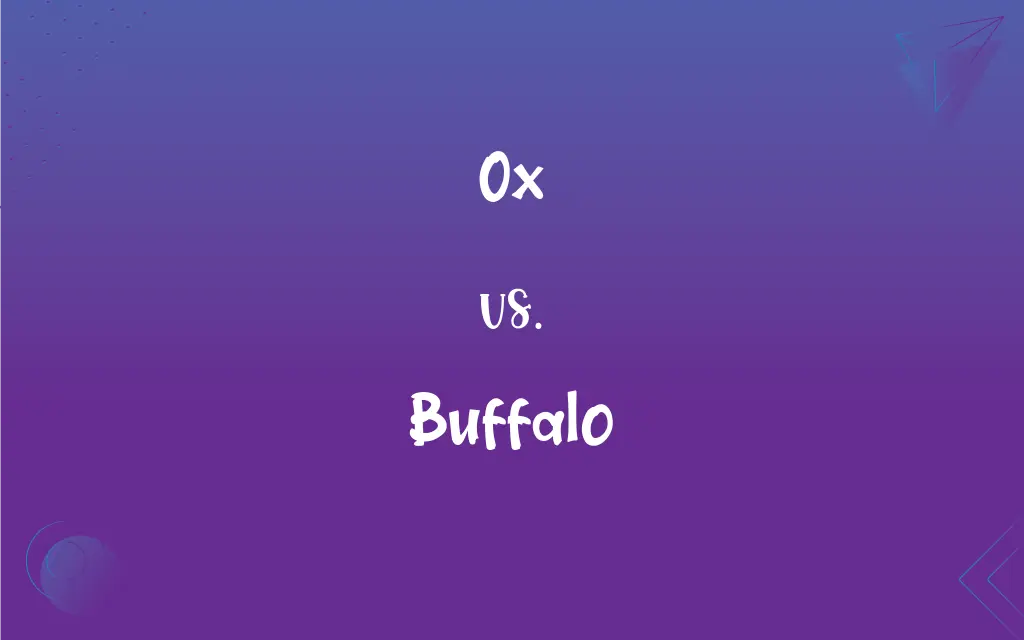Ox vs. Buffalo: What's the Difference?
Edited by Harlon Moss || By Janet White || Updated on October 7, 2023
An Ox is a domesticated bovine, often a castrated male, used for labor, while a Buffalo is a wild or domesticated species of large herbivorous mammals native to various regions.

Key Differences
Both Ox and Buffalo belong to the bovine family, but their roles and significance in human civilization vary. The term Ox specifically refers to a domesticated bovine, often a castrated male, which is trained to perform tasks like plowing or pulling loads. Buffalo, on the other hand, encompasses several species of large herbivorous mammals found in various parts of the world, including the African buffalo and the water buffalo.
An Ox is typically characterized by its docility, stemming from domestication, and its role in aiding labor. Buffalo are wild by nature, although certain species like the water Buffalo can also be domesticated for similar purposes, or for their milk and meat.
The physical appearance of an Ox and a Buffalo is distinct. Oxen are often breeds of cattle that have been repurposed for labor, so their appearance aligns with common cattle. Buffalo, depending on the species, can have large horns, distinctive humps, and a robust build, setting them apart from common cattle and oxen.
Geographically, while Ox is a term used globally for working bovines, the term Buffalo has regional implications. In North America, for instance, "buffalo" often refers to bison, even though bison are technically not true buffalo.
The relationship between humans and these animals is rooted in ancient practices. Oxen have been utilized for labor for millennia, symbolizing strength and endurance in many cultures. Buffalo, with their wild nature, have been hunted, revered, and domesticated in different parts of the world, playing a multifaceted role in human history.
ADVERTISEMENT
Comparison Chart
Definition
Domesticated bovine used for labor.
Large herbivorous mammal, wild or domesticated.
Domestication
Always domesticated.
Can be wild or domesticated.
Appearance
Similar to common cattle.
Large horns, humps, and robust build.
Geographic Reference
Global term.
Varies; in North America can refer to bison.
Relationship with Humans
Used mainly for labor.
Hunted, revered, domesticated, or used for meat/milk.
ADVERTISEMENT
Ox and Buffalo Definitions
Ox
A domesticated bovine used primarily for labor.
The farmer relied on the Ox to plow his fields.
Buffalo
In North America, sometimes refers to bison inaccurately.
Many mistakenly call the American bison a Buffalo.
Ox
Often a castrated male cattle trained for work.
The Ox pulled the heavy cart effortlessly.
Buffalo
Can refer to species like African buffalo or water buffalo.
The African Buffalo is known for its formidable horns.
Ox
Typically yoked in pairs for tasks.
The two oxen worked in tandem to move the logs.
Buffalo
Can be domesticated for milk, meat, or labor.
The farmer uses his Buffalo for plowing and for milk.
Ox
Provides meat known as oxen when slaughtered.
In some regions, Ox meat is a delicacy.
Buffalo
Any of several large African and Asian ruminant mammals of the family Bovidae, such as the water buffalo and the African buffalo.
Ox
Represents endurance and strength in many cultures.
The statue depicted an Ox, symbolizing perseverance.
Buffalo
The American bison (Bison bison).
Ox
An adult castrated bull of the genus Bos, especially B. taurus, used chiefly as a draft animal.
Buffalo
The flesh of the American bison, used as food.
Ox
A bovine mammal, especially one that has been domesticated.
Buffalo
Any of several North American suckers of the genus Ictiobus, having a dark body and an arched back. Also called buffalo fish.
Ox
An adult castrated male of cattle (B. taurus), especially when used as a beast of burden.
Buffalo
To intimidate or frighten, as by a display of authority
“The board couldn't buffalo the federal courts as it had the Comptroller” (American Banker).
Ox
Any bovine animal (genus Bos). A neat, a beef.
Buffalo
To confuse or deceive
“Too often ... job seekers have buffaloed lenders as to their competency and training” (H. Jane Lehman).
Ox
Abbreviation of oxygen
Buffalo
Any of the Old World mammals of the family Bovidae, such as the Cape buffalo, Syncerus caffer, or the water buffalo Bubalus bubalis.
Ox
The male of bovine quadrupeds, especially the domestic animal when castrated and grown to its full size, or nearly so. The word is also applied, as a general name, to any species of bovine animals, male and female.
All sheep and oxen, yea, and the beasts of the field.
Buffalo
A related North American animal, the American bison, Bison bison.
Ox
An adult castrated bull of the genus Bos; especially Bos taurus
Buffalo
Ellipsis of buffalo robe
Ox
Any of various wild bovines especially of the genera Bos or closely related Bibos
Buffalo
The buffalo fish (Ictiobus spp.).
Buffalo
A nickel.
Buffalo
(transitive) To hunt buffalo.
Buffalo
To outwit, confuse, deceive, or intimidate.
Buffalo
To pistol-whip.
Buffalo
A species of the genus Bos or Bubalus (Bubalus bubalus), originally from India, but now found in most of the warmer countries of the eastern continent. It is larger and less docile than the common ox, and is fond of marshy places and rivers.
Buffalo
A very large and savage species of the same genus (Syncerus Caffer syn. Bubalus Caffer) found in South Africa; - called also Cape buffalo.
Buffalo
Any species of wild ox.
Buffalo
The bison of North America.
Buffalo
A buffalo robe. See Buffalo robe, below.
Buffalo
The buffalo fish. See Buffalofish, below.
Buffalo
Large shaggy-haired brown bison of North American plains
Buffalo
A city on Lake Erie in western New York (near Niagara Falls)
Buffalo
Meat from an American bison
Buffalo
Any of several Old World animals resembling oxen including, e.g., water buffalo; Cape buffalo
Buffalo
Intimidate or overawe
Buffalo
A large herbivorous mammal, either wild or domesticated.
The water Buffalo grazed peacefully by the river.
Buffalo
Has cultural and spiritual significance in various societies.
The Buffalo holds a sacred place in Native American traditions.
FAQs
What is an Ox?
An Ox is a domesticated bovine, often used for labor.
Can Buffalo be domesticated like oxen?
Yes, certain species like the water Buffalo can be domesticated.
Is a bison a type of Buffalo?
No, while in North America bison are colloquially called "buffalo," they are technically not true buffalo.
Why are oxen often used for labor?
Due to their strength, endurance, and docility from domestication.
Which is larger, an Ox or a Buffalo?
Size can vary, but generally, buffalo, especially wild species, are larger.
Is a Buffalo the same as an Ox?
No, a Buffalo is a large herbivorous mammal, while an Ox is a domesticated bovine.
Do both Ox and Buffalo have horns?
Yes, but the size and shape of horns can vary widely between species and individual animals.
Where can you find Buffalo in the wild?
Depending on the species, buffalo can be found in Africa, Asia, and North America.
Are oxen always castrated males?
Often, but not always. The term can refer to both males and females used for labor.
Why do people refer to bison as buffalo in North America?
It's a historical misnomer that has persisted over time.
About Author
Written by
Janet WhiteJanet White has been an esteemed writer and blogger for Difference Wiki. Holding a Master's degree in Science and Medical Journalism from the prestigious Boston University, she has consistently demonstrated her expertise and passion for her field. When she's not immersed in her work, Janet relishes her time exercising, delving into a good book, and cherishing moments with friends and family.
Edited by
Harlon MossHarlon is a seasoned quality moderator and accomplished content writer for Difference Wiki. An alumnus of the prestigious University of California, he earned his degree in Computer Science. Leveraging his academic background, Harlon brings a meticulous and informed perspective to his work, ensuring content accuracy and excellence.































































